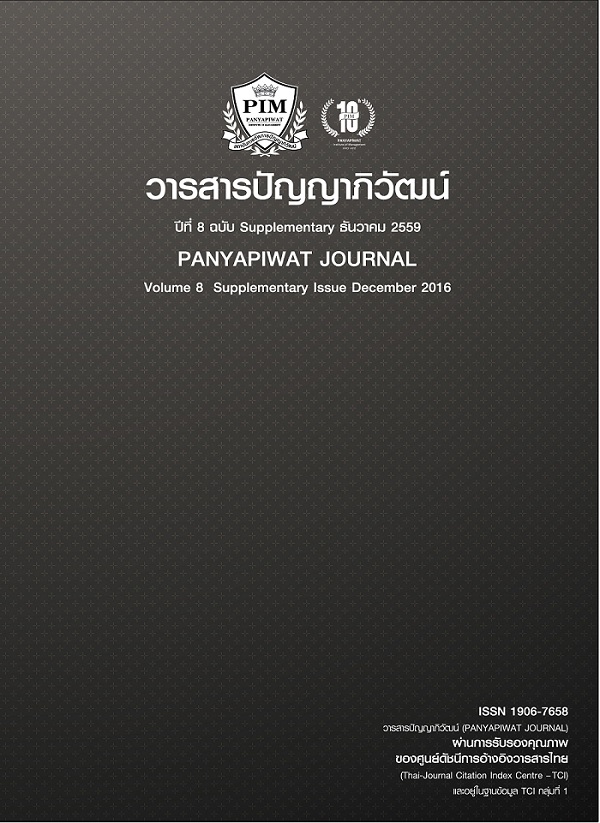人——组织匹配对员工创新行为的影响: 论创造力自我效能感的中介作用
Main Article Content
บทคัดย่อ
从人与情境互动的角度出发,探讨人——组织匹配对员工创新行为的影响机制。通过对350名在职员工的调查,发现人——组织匹配对员工创新行为、创造力自我效能感均有显著的正向影响,其中价值观匹配和要求——能力匹配对员工创新行为、创造力自我效能感具有显著的正向影响,而需求——供给匹配对员工创新行为和创造力自我效能感没有影响;创造力自我效能感对员工创新行为具有正向影响;创造力自我效能感在人——组织匹配与员工创新行为之间起到部分中介作用。文章基于社会交换等理论对研究结果进行了讨论,存在的局限性是文中只研究了创造力自我效能感作为中介变量,在未来的相关研究中,希望加入其他中介和调节变量,以建立更加完善的理论模型。
From the perspective of interaction between people and the environment, to explore the impact of Person—organization on employee’s Innovative behavior. Through the survey of 350 employees, it was found that Person—organization fit has a significant positive impact on employee’s innovative behavior and creative self—efficacy. The value congruence and the demands—abilities had significant positive impact on the employees' Innovative behavior, creative self—efficacy. The needs—supplies has no impact on the employee's Innovative behavior and the creative self—efficacy; the creative self—efficacy has positive impact on the employee's Innovative behavior; the creative self-efficacy play a part of the intermediary role between Person—organization and Employee’s Innovative behavior. This paper discusses the research results based on the theory of social exchange and other other related theories, the limitations of this paper are that only the Creative self-efficacy as the mediator variable, in the future related research, we hope to add other mediating and regulating variables to establish more perfect of the theoretical model.
Article Details
“ข้าพเจ้าและผู้เขียนร่วม (ถ้ามี) ขอรับรองว่า บทความที่เสนอมานี้ยังไม่เคยได้รับการตีพิมพ์และไม่ได้อยู่ระหว่างกระบวนการพิจารณาลงตีพิมพ์ในวารสารหรือแหล่งเผยแพร่อื่นใด ข้าพเจ้าและผู้เขียนร่วมยอมรับหลักเกณฑ์การพิจารณาต้นฉบับ ทั้งยินยอมให้กองบรรณาธิการมีสิทธิ์พิจารณาและตรวจแก้ต้นฉบับได้ตามที่เห็นสมควร พร้อมนี้ขอมอบลิขสิทธิ์บทความที่ได้รับการตีพิมพ์ให้แก่สถาบันการจัดการปัญญาภิวัฒน์หากมีการฟ้องร้องเรื่องการละเมิดลิขสิทธิ์เกี่ยวกับภาพ กราฟ ข้อความส่วนใดส่วนหนึ่งและ/หรือข้อคิดเห็นที่ปรากฏในบทความข้าพเจ้าและผู้เขียนร่วมยินยอมรับผิดชอบแต่เพียงฝ่ายเดียว”
References
Branstetter, I. (2006). Is Foreign Direct Investment a Channel of Knowledge Spillovers? Evidence from Japan FDI in the United States. Journal of International Economics, 68, 325-344.
Carmeli, A. & Schaubroeck, J. (2007). The influence of leaders’ and other referents’ normative Expectations on individual involvement in creative work. The Leadership Quarterly 18(1), 35-48.
Chen, J. L., You, M. L., Lin, Z. C. & Wu, Z. X. (2016). An Empirical research on the relationship between Human-Organization Matching and Individual Performance. Journal of Nanjing Audit University, 1, 21-31. [in Chinese]
Chiaburu, D. S., Thundiyil, T. & Wang, J. X. (2014). Alienation and Its Correlates: A Meta Analysis. European Management Journal, 32(1), 24-36.
Du, J. (2013). Dynamic Effect of Multilevel Leadership on Employee Responses to Organizational Change: Moderating Role of Chinese Traditional Culture. Advances in Psychological Science, 9, 1532-1541. [in Chinese]
Gong, Y., Huang, J. C. & Farh, J. L. (2009). Employee learning orientation, transformational leadership, and employee creativity: The mediating role of employee creative Self-efficacy. The Academy of Management Journal (AMJ),52(4), 765-778.
Greguras, G. J. & Diefendorff, J. M. (2009). Different Fits Satisfy Different Needs: Linking Person-Environment Fit to Employee Commitment and Performance Using Self-Determination Theory. Journal of Applied Psychology, 94(2), 465-477.
Gu, Y. D. & Peng, J. S. (2010). The Effect of Organizational Creative Climate on Creative Behavior: The Moderating Effect of Creative Self-efficacy. Nankai Business Review, 13(1),30-41.[in Chinese]
Ma, H. Y., Shen, C. G., Yang, J., Tang, Y. & Xie, J. L. (2014). Boundary Flexibility and Work-family Conflict and Enrichment: from Person-environment Fit Perspective. Acta Psychologica Sinica, 4, 540-551. [in Chinese]
Martín, P. (2007). Job Demands Job Resources and Individual Innovation at Work: Going Beyond Karasek’s Model?. Psicothema, 19(4), 621-626.
Sang, R. C. & Yue, Z. G. (2011). An Empirical Study on the Influence of FDI Spillover on China’s Innovation Capability. International Economics and Trade Research, 10, 40-45. [in Chinese]
Scott, S. G. & Bruce, R. A. (1994). Determinants of innovative behavior: A path model of individual innovation in the workplace. Academy of Management Journal,37(3), 580-607.
Tierney, P. & Farmer, S. M. (2004). Creative self-efficacy: Its potential antecedents and to creative performance. Academy of Management Journal, 45, 1137–1148.
Tierney, P. & Farmer, S. M. (2010). Creative self-efficacy development and creative performance over time. Journal of Applied Psychology, 96(2), 277-293.
Tu, X. Y., He, X. & Guo, J. M. (2015). Effects of Critical Thinking on Employee Innovation Behavior: Test of a Moderated Mediator Model. Science of Science and Management of S & T, 10, 169-180. [in Chinese]
Volmer, J. (2015). Followers’ Daily Reactions to Social Conflicts with Supervisors: the Moderating Role of Core Self-Evaluations and Procedural Justice Perceptions. The Leadership Quarterly,26(5), 719-731.
Woodman, R. W., Sawyer, J. E. & Griffin, R. W. (1993). Toward a Theory of Organizational Creativity. Academy of Management Review, 18(2), 293-321.
Yang, J, Z., Yang, D. T., Zhao, S. D. & Jing, L. D. (2011). The Motivation of Creativity: Employee Creative Self-efficacy. Advances in Psychological Science, 9, 1363-1370. [in Chinese]
Yao, Y. H. & Fan, Y. Y. (2014). The Impact of Person-organization Fit on Innovative Behavior— The Moderating Effects of Zhongyong Thinking and Chaxu Climate. East China Economic Management, 11, 123-127. [in Chinese]
Zhang, H. Q., Lu, R. Y. & Jiang, Y. (2012). Customer Knowledge Management’s Measurement Tool Research in Service Innovation Process: Scale development and Verification——based on the study of mobile communication service industry. Management Review, 24(2), 94-103. [in Chinese]
ZHou, M. J., SHi, S. S. & Jiang, J. J. (2011). Person-job Fit and Work Attitudes: Self-efficacy as a Mediator. Industrial Engineering and Management, 5, 123-129. [in Chinese]

